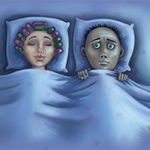Another common OSA variant: Upper airway resistance syndrome, which doctors see more in women with fibromyalgia, Dr. Rosenberg says. “Their oxygen level doesn’t drop, but they do wake up,” he says.
Not all fibromyalgia patients are screened for OSA, but Dr. Dasgupta does keep it in mind. “If a fibromyalgia patient is getting seven to eight hours of sleep but isn’t refreshed, I have a low threshold to screen for OSA,” he says.
Doctors commonly treat OSA with a continuous airway pressure (CPAP) mask. Patients may have seen family members use bulky CPAPs and, in turn, resist getting one, but Dr. Dasgupta tries to reassure them. “Use of a CPAP does require a mask, but not all of them make you look like Darth Vader,” he says. Additionally, patients with OSA sometimes find success with positional therapy, a dental device or even surgery including tonsil removal instead of CPAP use. “Most of the older [surgical approaches] are not successful, but they still have a place for some patients,” Dr. Rosenberg says.
Sleep specialists also discuss the importance of weight loss and exercise when necessary with patients who have OSA, Dr. Dasgupta says. Often, patients with OSA feature other concurrent health issues, including obesity, cardiac disease and diabetes. Physicians also must evaluate whether the patient takes other medications that may make breathing worse, or if the patient has had undiagnosed OSA, he adds.
Treating OSA in fibromyalgia patients tends to be effective, Dr. Rosenberg says. “Fatigue improves significantly, and pain tends to diminish. Sleep becomes more consolidated, there are prolonged periods of REM sleep, and there’s more production of growth hormone.”
Restless leg syndrome (RLS) also frequently occurs among fibromyalgia patients, particularly among iron-deficient women and women of reproductive age, Dr. Dasgupta says. In fact, doctors see RLS in roughly 50% of fibromyalgia patients, he says. Symptoms include leg twitching that’s worse at night and when resting; movement relieves the feeling. Although RLS is not officially a sleep disorder, it does cause problems sleeping. “It’s not unusual for doctors to dismiss the symptoms and say it’s fibromyalgia pain,” Dr. Rosenberg says.
RLS requires identification of the root cause, such as iron deficiency, kidney problems or undiagnosed diabetes, and medications can treat it. And, as with OSA, treating RLS tends to help fibromyalgia symptoms.
Insomnia also commonly affects fibromyalgia patients. Ms. Kormeili is a certified insomnia therapist, which means she uses cognitive behavioral therapy (CBT) to treat insomnia. “Cognitive behavioral therapy focuses on changes in thoughts and behaviors that maintain sleep problems,” she says. Using CBT for insomnia can help fibromyalgia patients with their pain management.

